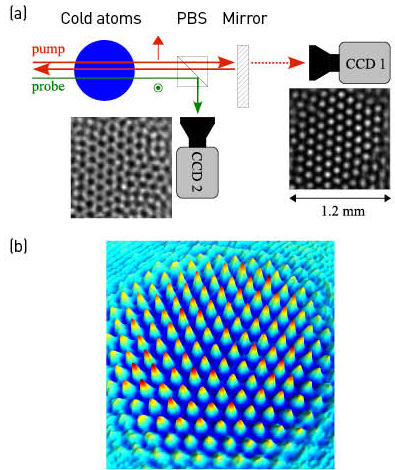
(a) A pump beam tuned to the high-frequency side of the D2 line passes through a cold cloud of 87Rb atoms and is retro-reflected. Charge-coupled device (CCD) 1 detects transverse structures in the intensity distribution of the transmitted pump. An orthogonally polarized probe beam passes through the cloud after the pump pulse; it is redirected using a polarizing beam splitter (PBS), and the transverse spatial organization of the atoms is detected at CCD 2. (b) 3-D view of a large-scale hexagonal structure in the transverse section of the pump beam.
Optomechanics, the mutual coupling of light and matter via optical forces, can lead to spectacular examples of spontaneous spatial organization.1 Cold and ultracold atoms have emerged as useful systems in which to study these effects, as they are highly sensitive to the dipole force exerted by a spatially inhomogeneous light field. Although experiments to date have been performed mainly in optical cavities that provide a single mode for the spatial organization of the atoms, interesting predictions have been made for multimode situations.2
We used a simple single-pump-beam, single-mirror feedback scheme to demonstrate the spontaneous spatial organization of a cold atomic cloud in the plane transverse to the pump axis.3 Such a setup has been shown to lead to pattern formation in various nonlinear media (including hot atomic vapors), but the spatial modulation has only affected the atomic internal states, while the atomic density remained homogeneous.4 Cold atoms can easily bunch into potential wells created by the dipole force in a modulated light field. In our work, the instability also leads to a simultaneous high-contrast spatial modulation of the atomic density. Since the system is, in principle, translation invariant in the transverse plane and symmetric about the pump axis, two continuous symmetries (translation and rotation) are spontaneously broken in the process, and the spatial organization can adopt a multitude of different modes.
In our feedback experiment, two distinct nonlinear mechanisms are at work: the “electronic” nonlinearity based on purely internal states, and the “optomechanical” one resulting from the spatial structuring of the atoms. We will continue to investigate the properties of these various instabilities. Because the pump light is detuned from the atomic transition, the atomic motion in the dipole potential landscape is essentially Hamiltonian and free from damping.5 The concept of our experiment can then be extended to ultracold atoms, such as those produced in a Bose-Einstein condensate, to address the quantum physics of multi-mode systems.
Researchers
Guillaume Labeyrie and Robin Kaiser, Institut Non Linéaire de Nice, France
Enrico Tesio, Pedro M. Gomes, Gian-Luca Oppo, William J. Firth, Gordon R.M. Robb, Aidan S. Arnold and Thorsten Ackemann, University of Strathclyde, Glasgow, U.K.
References
1. F. Brennecke et al. Science 322, 235 (2008).
2. S. Gopalakrishnan et al. Nat. Phys. 5, 845 (2009).
3. G. Labeyrie et al. Nat. Photonics 8, 321 (2014).
4. G. Grynberg et al. Phys. Rev. Lett. 72, 2379 (1994).
5. E. Tesio et al. Phys. Rev. Lett. 112, 043901 (2014).
